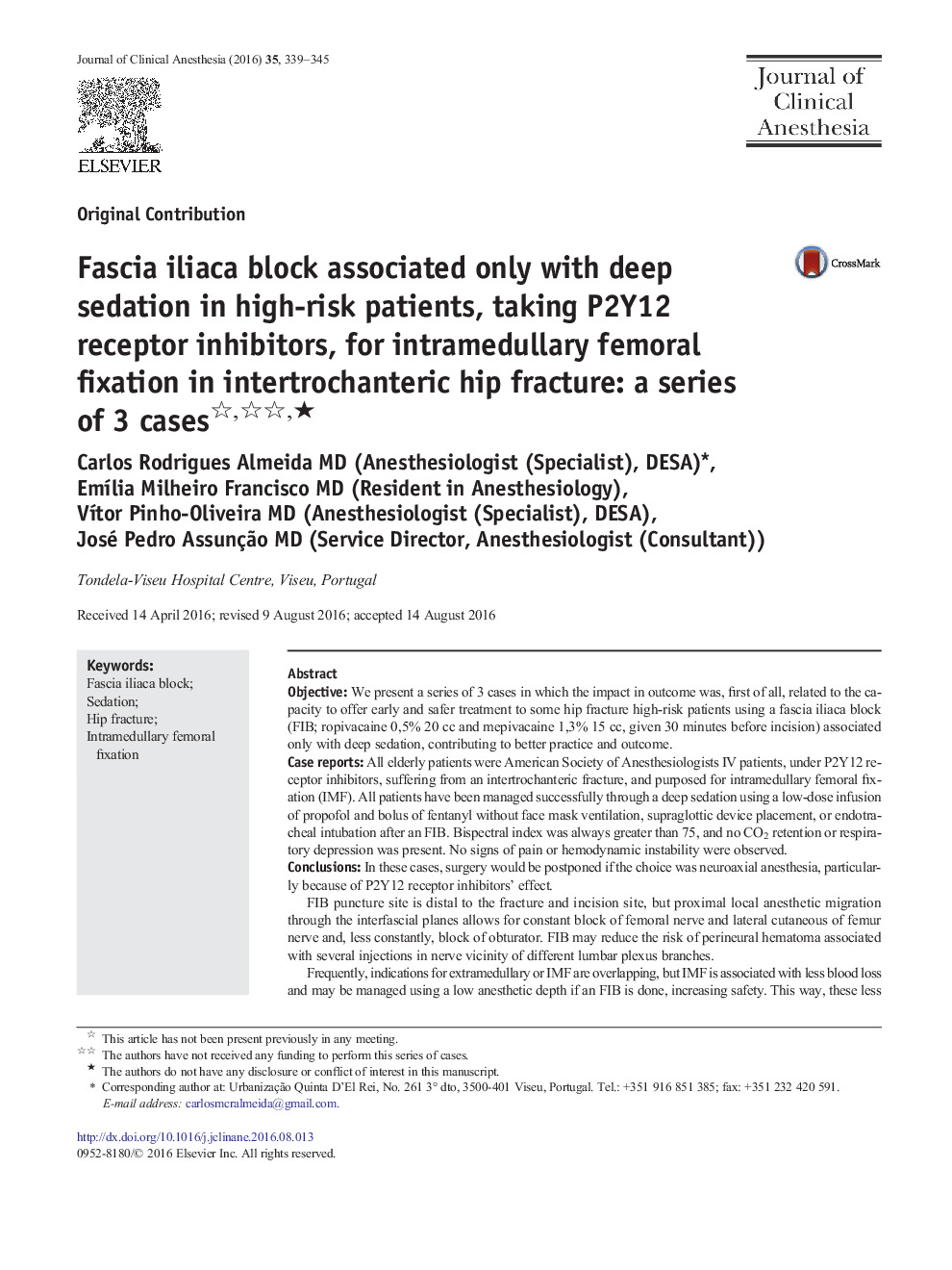| Article ID | Journal | Published Year | Pages | File Type |
|---|---|---|---|---|
| 5884312 | Journal of Clinical Anesthesia | 2016 | 7 Pages |
â¢Fascia iliaca block (FIB) associated only with deep sedation for intramedullary femoral fixation (IMF) may contribute to better practice and outcome.â¢All elder patients were American Society of Anesthesiologists IV patients, under P2Y12 receptor inhibitors, having high-risk for general anesthesia, suffering from an intertrochanteric fracture, and purposed for IMF.â¢All cases have been managed successfully through a deep sedation using a low-dose infusion of propofol and bolus of fentanyl without airway manipulation after an FIB.â¢In these cases, surgery would be postponed if the choice was neuroaxial anesthesia, particularly because of P2Y12 receptor inhibitors effect.â¢FIB may reduce the risk of perineural hematoma associated with several injections in nerve vicinity of different lumbar plexus branches.â¢Frequently indications for extramedullary or IMF are overlapping, but IMF is associated with less blood loss and may be managed using a low anesthetic depth if an FIB is done, increasing safety.â¢These less invasive surgical techniques combined with an adjusted anesthetic technique may have a crucial role in high-risk patients, particularly if taking P2Y12 receptor inhibitors.â¢In these cases, surgical manipulation in IMF of sciatic or inferior subcostal nerves territories was managed with systemic analgesia and deep sedation.
ObjectiveWe present a series of 3 cases in which the impact in outcome was, first of all, related to the capacity to offer early and safer treatment to some hip fracture high-risk patients using a fascia iliaca block (FIB; ropivacaine 0,5% 20 cc and mepivacaine 1,3% 15 cc, given 30 minutes before incision) associated only with deep sedation, contributing to better practice and outcome.Case reportsAll elderly patients were American Society of Anesthesiologists IV patients, under P2Y12 receptor inhibitors, suffering from an intertrochanteric fracture, and purposed for intramedullary femoral fixation (IMF). All patients have been managed successfully through a deep sedation using a low-dose infusion of propofol and bolus of fentanyl without face mask ventilation, supraglottic device placement, or endotracheal intubation after an FIB. Bispectral index was always greater than 75, and no CO2 retention or respiratory depression was present. No signs of pain or hemodynamic instability were observed.ConclusionsIn these cases, surgery would be postponed if the choice was neuroaxial anesthesia, particularly because of P2Y12 receptor inhibitors' effect.FIB puncture site is distal to the fracture and incision site, but proximal local anesthetic migration through the interfascial planes allows for constant block of femoral nerve and lateral cutaneous of femur nerve and, less constantly, block of obturator. FIB may reduce the risk of perineural hematoma associated with several injections in nerve vicinity of different lumbar plexus branches.Frequently, indications for extramedullary or IMF are overlapping, but IMF is associated with less blood loss and may be managed using a low anesthetic depth if an FIB is done, increasing safety. This way, these less invasive surgical techniques combined with an adjusted anesthetic technique may have a crucial role in high-risk patients, particularly if taking P2Y12 receptor inhibitors. In these cases of IMF, surgical manipulation of sciatic and/or inferior subcostal nerves territories was managed with systemic analgesia and deep sedation.
